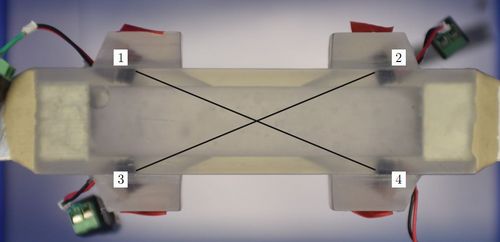Ultrasound-based Velocity Measurement using the Sing-around-technique
Franz Huber

In this thesis, a measuring system for very low flow velocities in the range of 50 µm/s for leakage detection in household water mains was set up and examined. For this purpose, the ultrasonic time-of-flight principle is exploited. This method is based on different propagation velocities caused by the flow and thus different propagation times of the ultrasonic waves with and against the flow direction. This method requires a very high time resolution for measuring low flow velocities, since the propagation times differ only minimally for the opposing directions.
A method to reduce the resolution requirement of the time measurement or to increase the accuracy of the measurement of the flow velocity for a given temporal resolution is the so-called sing-around technique. The suitability of this method is examined in the present work. In this method, the length of the propagation path is virtually lengthened by sending a new ultrasonic pulse in the same direction immediately after receiving one at the end of the propagation path. This is done N times for both directions, which increases the propagation time difference by this factor. The unknown flow velocity is calculated from the time difference.
 Figure 1: 3D-printed measurement profile with black ultrasonic transducers (1, 2, 3, 4) and two measurement paths (1-4, 2-3).
Figure 1: 3D-printed measurement profile with black ultrasonic transducers (1, 2, 3, 4) and two measurement paths (1-4, 2-3).
In this thesis, the implemented system was built up invasively, which means that the ultrasonic transducers used for the measurement are in direct contact with the flowing medium. For this purpose, a suitable measuring section was manufactured with a 3D-printer, in which ultrasonic transducers are mounted for the measurements (figure 1). The signals from the transducers are processed by the designed and built up electronics (figure 2). Furthermore, the entire system and its components were characterized. The time fluctuations of all components and their influence on the accuracy of the measuring system were examined.
During the characterization of the built-up system it turned out that the given component, which is used for the excitation of the system, has a big influence on the time resolution of the system. Due to its dependence on a clock, the resolution of the time measurement is only approximately 25 ns. A flow velocity measurement is therefore possible in principle, but not with the desired accuracy. Finally, it is discussed how the time resolution of the system can be increased in possible future work in order to be able to measure lower flow velocities.
 Figure 2: Used measuring electronics.
Figure 2: Used measuring electronics.
Keywords: sing-around-technique, speed of sound, velocity measurement, ultrasound
May 13th, 2020
 Go to JKU Homepage
Go to JKU Homepage


